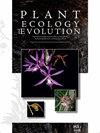萨尔达湖(土耳其安纳托利亚)一个深苏打湖中的三个新Achnanthidium(Bacillarophyceae)物种
IF 1.1
4区 生物学
Q3 PLANT SCIENCES
引用次数: 1
摘要
背景和目的-Kützing根据两个物种将瘦子属从瘦子属中分离出来:瘦子属和小头瘦子属。这两个属的区别在于在瘦子属中存在茎,而在瘦子中不存在茎。在电子显微镜检查之前,瘦子和瘦子的区别并不清楚,尤其是在瘦子中。本研究的目的是描述萨尔达湖上的三个新物种。材料和方法-萨尔达湖位于土耳其安纳托利亚西南部。硅藻是在2016年至2020年间从湖中的四个站点季节性收集的,来自不同的基质(表生、附生和表石器时代)。关键结果——在土耳其萨尔达湖发现了三个属于阿楠属的新种。根据形态学观察,所有新的分类群都属于小瘦麻复合体的一部分。barlasii Achanthidium sp.nov.和A.dumlupinarii sp.nov..显示出高度的相似性,但可以根据瓣膜轮廓和更密集的晕染来分离,尤其是在靠近中缝瓣顶端的条纹中。这两个物种都可以根据更多独立的顶端和更少的椭圆形瓣叶与微小A.minutissimum区分开来。在A.dumlupinarii sp.nov.的情况下,大型标本显示出瓣膜的轻微波动,这是一个独特的特征。锐钛矿扁藻最具特征的是其瓣叶宽度、宽圆形的瓣叶顶端和几乎笔直的瓣叶。所有新描述的阿胶都可以在扁豆环境中发现,这些环境具有碱性水和高钙离子含量。结论:新描述的分类群发生在一个苏打湖的独特栖息地。该湖的环境是高度碱性的,富含镁和钙,来源于石灰岩和白云质石灰岩。本文章由计算机程序翻译,如有差异,请以英文原文为准。
Three new Achnanthidium (Bacillariophyceae) species from Lake Salda (Anatolia, Turkey), a deep soda lake
Background and aims – Kützing separated the genus Achnanthidium from the genus Achnanthes based on two species: Achnanthes minutissima and Achnanthidium microcephalum. These two genera were distinguished by the presence of stalks in the Achnanthes genus and their absence in Achnanthidium. Before electron microscopy, the difference between Achnanthes and Achnanthidium was not clear, especially in Achnanthidium minustissimum sensu lato. The aim of the study is to describe three new species of Achnanthidium from Lake Salda.
Material and methods – Lake Salda is located in southwestern Anatolia, in Turkey. The diatoms were collected seasonally from four stations in the lake between 2016 and 2020, from different substrata (epipelic, epiphytic, and epilithic).
Key results – Three new species belonging to the genus Achnanthidium have been found in Lake Salda, Turkey. Based on the morphological observations, all new taxa are part of the Achnanthidium minutissimum complex. Achnanthidium barlasii sp. nov. and A. dumlupinarii sp. nov. show a high degree of similarity to each other, but can be separated based on valve outline and a denser areolation, especially in striae close to the apices of the raphe valve. Both species can be distinguished from A. minutissimum based on more separate apices and less elliptic valves. In the case of A. dumlupinarii sp. nov., large specimens show slight undulations of the valve, which is a unique feature. Achnanthidium anatolicum sp. nov. is the most characteristic based on its valve width, broadly rounded valve apices, and almost straight valves in girdle view. All newly described Achnanthidium species can be found in lentic environments, with alkaline water and high calcium ion content.
Conclusion – The newly described taxa occurred in the unique habitat of a soda lake. The environment of the lake is highly alkaline, rich in magnesium and calcium, and derived from limestone and dolomitic limestone rocks.
求助全文
通过发布文献求助,成功后即可免费获取论文全文。
去求助
来源期刊

Plant Ecology and Evolution
PLANT SCIENCES-
CiteScore
2.20
自引率
9.10%
发文量
27
审稿时长
>12 weeks
期刊介绍:
Plant Ecology and Evolution is an international peer-reviewed journal devoted to ecology, phylogenetics and systematics of all ‘plant’ groups in the traditional sense (including algae, cyanobacteria, fungi, myxomycetes), also covering related fields.
The journal is published by Meise Botanic Garden and the Royal Botanical Society of Belgium.
 求助内容:
求助内容: 应助结果提醒方式:
应助结果提醒方式:


